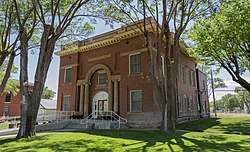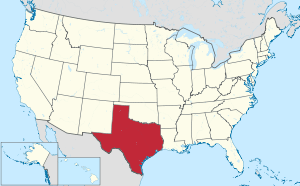Hartley County, Texas
Hartley County is a county located in the U.S. state of Texas. As of the 2010 census, its population was 6,062.[1] The county seat is Channing.[2] The county was created in 1876 and later organized in 1891.[3] It is named for Oliver C. Hartley and his brother, Rufus K. Hartley, two early Texas legislators and lawyers.
Hartley County | |
|---|---|
 1906 Hartley County Courthouse | |
 Location within the U.S. state of Texas | |
 Texas's location within the U.S. | |
| Coordinates: 35°50′N 102°37′W | |
| Country | |
| State | |
| Founded | 1891 |
| Seat | Channing |
| Largest community | Dalhart |
| Area | |
| • Total | 1,463 sq mi (3,790 km2) |
| • Land | 1,462 sq mi (3,790 km2) |
| • Water | 1.2 sq mi (3 km2) 0.08%% |
| Population (2010) | |
| • Total | 6,062 |
| • Density | 4.1/sq mi (1.6/km2) |
| Time zone | UTC−6 (Central) |
| • Summer (DST) | UTC−5 (CDT) |
| Congressional district | 13th |
| Website | www |
Geography
According to the U.S. Census Bureau, the county has a total area of 1,463 square miles (3,790 km2), of which 1,462 square miles (3,790 km2) is land and 1.2 square miles (3.1 km2) (0.08%) is water.[4]
Major highways




Adjacent counties
- Dallam County (north)
- Moore County (east)
- Oldham County (south)
- Quay County, New Mexico (southwest/Mountain Time Zone)
- Union County, New Mexico (northwest/Mountain Time Zone)
Demographics
| Historical population | |||
|---|---|---|---|
| Census | Pop. | %± | |
| 1880 | 100 | — | |
| 1890 | 252 | 152.0% | |
| 1900 | 377 | 49.6% | |
| 1910 | 1,298 | 244.3% | |
| 1920 | 1,109 | −14.6% | |
| 1930 | 2,185 | 97.0% | |
| 1940 | 1,873 | −14.3% | |
| 1950 | 1,913 | 2.1% | |
| 1960 | 2,171 | 13.5% | |
| 1970 | 2,782 | 28.1% | |
| 1980 | 3,987 | 43.3% | |
| 1990 | 3,637 | −8.8% | |
| 2000 | 5,537 | 52.2% | |
| 2010 | 6,062 | 9.5% | |
| Est. 2019 | 5,576 | [5] | −8.0% |
| U.S. Decennial Census[6] 1850–2010[7] 2010–2014[1] | |||
As of the census[8] of 2000, there were 5,537 people, 1,604 households, and 1,220 families residing in the county. The population density was 4 people per square mile (1/km²). There were 1,760 housing units at an average density of 1 per square mile (0/km²). The racial makeup of the county was 81.07% White, 8.15% Black or African American, 0.43% Native American, 0.27% Asian, 0.05% Pacific Islander, 8.60% from other races, and 1.43% from two or more races. 13.69% of the population were Hispanic or Latino of any race. In terms of ancestry, 21.0% were of German, 12.6% were of English, 12.3% were of Irish, 6.6% were of American, 4.3% were of French, 3.0% were of Scottish, 3.0% were of Dutch.
There were 1,604 households out of which 35.50% had children under the age of 18 living with them, 68.90% were married couples living together, 4.70% had a female householder with no husband present, and 23.90% were non-families. 21.60% of all households were made up of individuals and 11.80% had someone living alone who was 65 years of age or older. The average household size was 2.56 and the average family size was 2.98.
In the county, the population was spread out with 20.80% under the age of 18, 4.70% from 18 to 24, 35.70% from 25 to 44, 26.90% from 45 to 64, and 11.90% who were 65 years of age or older. The median age was 40 years. For every 100 females there were 154.10 males. For every 100 females age 18 and over, there were 172.90 males.
The median income for a household in the county was $46,327, and the median income for a family was $53,004. Males had a median income of $29,783 versus $21,783 for females. The per capita income for the county was $18,067. About 3.70% of families and 6.60% of the population were below the poverty line, including 8.00% of those under age 18 and 5.30% of those age 65 or over.
Government and infrastructure
The Texas Department of Criminal Justice operates the Dalhart Unit prison in an unincorporated area in the county, near Dalhart.[9]
Politics
| Year | Republican | Democratic | Third parties |
|---|---|---|---|
| 2016 | 88.6% 1,730 | 8.9% 173 | 2.5% 49 |
| 2012 | 89.3% 1,708 | 9.6% 184 | 1.1% 21 |
| 2008 | 86.2% 1,711 | 12.6% 250 | 1.2% 24 |
| 2004 | 84.3% 1,736 | 15.3% 315 | 0.4% 8 |
| 2000 | 81.0% 1,645 | 17.7% 359 | 1.3% 27 |
| 1996 | 68.7% 1,242 | 25.6% 463 | 5.8% 104 |
| 1992 | 60.2% 1,081 | 22.6% 406 | 17.3% 310 |
| 1988 | 70.4% 1,229 | 28.9% 505 | 0.7% 13 |
| 1984 | 79.5% 1,419 | 19.9% 356 | 0.6% 11 |
| 1980 | 71.0% 1,248 | 26.8% 470 | 2.2% 39 |
| 1976 | 50.8% 811 | 48.5% 774 | 0.8% 12 |
| 1972 | 80.2% 946 | 17.5% 206 | 2.4% 28 |
| 1968 | 51.5% 597 | 25.8% 299 | 22.8% 264 |
| 1964 | 43.6% 437 | 56.3% 565 | 0.1% 1 |
| 1960 | 50.7% 413 | 48.7% 397 | 0.6% 5 |
| 1956 | 44.0% 353 | 55.8% 448 | 0.3% 2 |
| 1952 | 53.6% 468 | 46.0% 402 | 0.5% 4 |
| 1948 | 14.6% 83 | 84.1% 477 | 1.2% 7 |
| 1944 | 5.0% 26 | 93.1% 484 | 1.9% 10 |
| 1940 | 16.8% 110 | 83.2% 545 | |
| 1936 | 6.7% 40 | 93.3% 560 | |
| 1932 | 11.2% 74 | 88.8% 586 | |
| 1928 | 52.3% 179 | 47.7% 163 | |
| 1924 | 25.1% 61 | 64.2% 156 | 10.7% 26 |
| 1920 | 34.6% 81 | 61.5% 144 | 3.9% 9 |
| 1916 | 15.5% 30 | 83.4% 161 | 1.0% 2 |
| 1912 | 9.8% 16 | 70.7% 116 | 19.5% 32 |
Gallery
- Dalhart Grain Elevator Coop in Hartley
- Hartley High School in Hartley
- Abandoned building in northern Hartley County
See also
References
- "State & County QuickFacts". United States Census Bureau. Archived from the original on August 6, 2011. Retrieved December 17, 2013.
- "Find a County". National Association of Counties. Retrieved 2011-06-07.
- "Texas: Individual County Chronologies". Texas Atlas of Historical County Boundaries. The Newberry Library. 2008. Retrieved May 24, 2015.
- "2010 Census Gazetteer Files". United States Census Bureau. August 22, 2012. Retrieved April 28, 2015.
- "Population and Housing Unit Estimates". United States Census Bureau. May 24, 2020. Retrieved May 27, 2020.
- "U.S. Decennial Census". United States Census Bureau. Retrieved April 28, 2015.
- "Texas Almanac: Population History of Counties from 1850–2010" (PDF). Texas Almanac. Retrieved April 28, 2015.
- "U.S. Census website". United States Census Bureau. Retrieved 2011-05-14.
- "Dalhart Unit Archived 2010-07-25 at the Wayback Machine." Texas Department of Criminal Justice. Retrieved on June 4, 2010.
- Leip, David. "Dave Leip's Atlas of U.S. Presidential Elections". uselectionatlas.org. Retrieved 11 April 2018.
